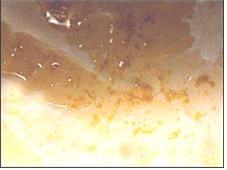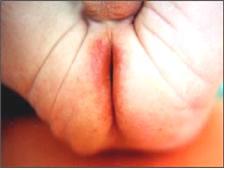위장관 식품 알레르기( 소화기계 식품 알레르기) Food allergy of gastrointestinal system

사진 151. 식품 알레르기로 설사를 할 수 있다.
Copyright ⓒ 2011 John Sangwon Lee, MD., FAAP

사진 152. 식품 알레르기로 설사도 할 수 있고 항문 주위 피부염도 생길 수 있다.
Copyright ⓒ 2011 John Sangwon Lee, MD., FAAP
- 영유아들이나 학령기 아이들이 식품 알레르기를 잘 일으킬 수 있는 음식물을 먹을 때 알레르기 질환이 소화기계, 특히 위장관에 비교적 잘 생길 수 있다.
- 어디가 아픈 것을 말로 잘 표현할 수 없는 영유아들의 위장관에 식품 알레르기가 생기면 확실한 이유가 없이 자주 울고 짜증내고 보챌 수 있다.
- 그리고 잠을 잘 자지 않는다.
- 그 외 구토, 설사, 복통, 위장경련, 혈변, 점액변, 영아산통 등의 증상 징후가 생길 수 있다.
- 어떤 종류의 식품을 섭취한 후 위장관에 식품 알레르기가 생겨 고생하는 소아청소년들은 위장관에 식품 알레르기를 일으켰던 음식물을 또 먹으라고 주면 먹지 않고 그 음식물을 먹기 싫다고 거절하는 아이들도 있다.
- 말로 싫다고 표현을 할 수 없는 영유아들은 위장관 알레르기를 일으켰던 음식물을 손으로 밀거나 또 입을 다물고 받아먹지 않을 수 있다. 이런 경우를 “음식물 회피 현상(Food evasion)”이라고 한다.
- 식품 알레르기를 일으키는 음식물을 장기간 계속 먹이면 영양실조에 걸리고 성장 발육 지연도 생긴다.
- 우유 단백질이나 콩 단백질이 든 인공영양을 먹는 신생아들이나 영유아들에게 그 음식물로 식품 알레르기가 생길 수 있다. 그래서 배가 아프고, 설사하고, 구토할 수 있고 영아산통이 생길 수 있다.
- 신생아들이나 영아들에게 생기는 영아산통도 식품 알레르기로 생기는 증상이라고 한다. 영아들이 영아산통에 걸리면 신생아나 영아가 심하게 울고 보채고 잠도 잘 못 잔다.
- 우유 단백질에 알레르기가 심하게 생기는 영아들은 우유 단백질의 성분이 조금 든 식품이나 우유 단백질이 든 인공영양 등을 조금 먹을 때도 위장관 우유 알레르기가 생길 수 있다.
- 식품 알레르기로 이유 없이 구토, 설사, 복통 등의 증상이 생길 수 있다. [부모도 반의사가 되어야한다-소아가정간호백과]-제6권 신생아 성장 발육 양호 질환-영아산통 참조.
- 위장관에 생긴 식품 알레르기로 위장 벽 점막층이 붓고 손상될 수 있고 그로 인해 손상된 위장관 점막층에서 피가 나서 그 피가 대변에 나와 육안으로 볼 수 있을 정도로 섞여 나올 수 있다. 때로는 육안으로 볼 수 없을 정도로 소량 나올 수 있다. 이런 출혈을 잠복성 출혈(잠혈)이라고도 한다.
- 드물게는 점액 변도 나온다.
- 위장관 식품 알레르기를 일으키는 음식물을 장기간 계속 많이 먹으면 증상이 더 심해 질 수 있다. 드물게는 식품 알레르기로 아나필락시스이 생길 수 있고 그로 인해 심하게 앓거나 사망할 수 있다. 가성빈혈, 집중력 결여증, 편두통, 활동과다증, 현기증 등의 증상 징후가 위장관 이외 다른 신체의 각 계통에도 먹은 음식물로 식품 알레르기가 생길 수 있다.
- 글루텐 유발성 장증(셀이악 병), 호산성 식도염, 호산성 위장염 등도 위장관 식품 알레르기 질환에 속한다.
- 나올 수 있다. 때로는 육안으로 볼 수 없을 정도로 소량 나올 수 있다. 이런 출혈을 잠복성 출혈(잠혈)이라고도 한다.
- 드물게는 점액 변도 나온다.
- 위장관 식품 알레르기를 일으키는 음식물을 장기간 계속 많이 먹으면 증상이 더 심해 질 수 있다. 드물게는 식품 알레르기로 아나필락시스이 생길 수 있고 그로 인해 심하게 앓거나 사망할 수 있다. 가성빈혈, 집중력 결여증, 편두통, 활동과다증, 현기증 등의 증상 징후가 위장관 이외 다른 신체의 각 계통에도 먹은 음식물로 식품 알레르기가 생길 수 있다.
글루텐 유발성 장증(셀이악 병), 호산성 식도염, 호산성 위장염 등도 위장관 식품 알레르기 질환에 속한다
Food allergy of gastrointestinal system 위장관 식품 알레르기( 소화기계 식품 알레르기)

Picture 151. Food allergy can cause diarrhea.
Copyright ⓒ 2011 John Sangwon Lee, MD., FAAP Photo

152. Food allergy can cause diarrhea and perianal dermatitis. Copyright ⓒ 2011 John Sangwon Lee, MD., FAAP
• When infants and school-age children eat foods that can cause food allergies, allergic disorders can be relatively prevalent in the digestive system, especially the gastrointestinal tract.
• Food allergies in the gastrointestinal tract of infants and toddlers, who can’t verbally describe the pain somewhere, can often cry, irritate, and resent for no apparent reason.
• And I don’t sleep well.
• Other symptoms may include vomiting, diarrhea, abdominal pain, gastrointestinal cramps, bloody stools, mucous stools, and infant colic.
• Children and adolescents who suffer from food allergies in the gastrointestinal tract after eating some kind of food, some children refuse to eat the food that caused the food allergy in the gastrointestinal tract and refuse to eat it.
• Infants and toddlers who are unable to express dislike with words may not eat the food that caused gastrointestinal allergies with their hands or with their mouths closed. This case is called “food evasion.”
• Continued feeding of foods that cause food allergies for long periods of time leads to malnutrition and delays in growth and development.
• Newborns and infants who eat artificial nutrition with milk protein or soy protein can develop food allergies from the food. This can lead to stomach aches, diarrhea, vomiting, and infant colic.
• Infant colic in newborns and infants is also a symptom of food allergies. When infants suffer from infant colic, newborns or infants cry badly, sneeze, and sleep poorly.
• Infants who are severely allergic to milk protein may develop gastrointestinal milk allergy when eating a small amount of foods containing a small amount of milk protein or artificial nutrition containing milk protein.
• Food allergies can cause symptoms such as vomiting, diarrhea, and abdominal pain for no reason. www.drleepediatrics.com-Volume 6 Newborn’s Growth and Developmental Diseases-Refer to Infant Colic.
• Food allergies to the gastrointestinal tract can cause swelling and damage to the mucous membrane of the gastrointestinal tract, resulting in bleeding from the damaged gastrointestinal mucosa, causing the blood to enter the stool and mix enough to be seen with the naked eye. Sometimes it can come out in small amounts that are invisible to the naked eye. This bleeding is also called latent bleeding (occult blood).
• Rarely, mucous stools are also present.
• If you eat a lot of foods that cause gastrointestinal food allergies over a long period of time, your symptoms may get worse. Rarely, food allergies can lead to anaphylaxis, which can lead to severe illness or death. Symptoms such as pseudo anemia, lack of concentration, migraine, hyperactivity, and dizziness may lead to food allergies from food eaten in each system of the body other than the gastrointestinal tract.
• Gluten-induced bowel disease (celiac disease), eosinophilic esophagitis, and eosinophilic gastroenteritis are also food allergic diseases of the gastrointestinal tract.
출처 및 참조 문헌 Sources and references
- NelsonTextbook of Pediatrics 22ND Ed
- The Harriet Lane Handbook 22ND Ed
- Growth and development of the children
- Red Book 32nd Ed 2021-2024
- Neonatal Resuscitation, American Academy Pediatrics
-
Childhood Emergencies in the Office, Hospital and Community, American Academy of Pediatrics
-
Emergency Medical Service for Children, By Ross Lab. May 1989. p.10
-
Emergency care, Harvey grant, and Robert Murray
-
Emergency Care Transportation of Sick and Injured American Academy of Orthopaedic Surgeons
-
Emergency Pediatrics A Guide to Ambulatory Care, Roger M. Barkin, Peter Rosen
-
Immediate care of the acutely ill and injured, Hugh E. Stephenson, Jr
-
The Critically Ill Child, Diagnosis and Management, Edited by Clement A. Smith
-
Emergency Medical Services for Children: The Role of the Primary Care Provider, America Academy of Pediatrics
-
Quick Reference To Pediatric Emergencies, Delmer J. Pascoe, M.D., Moses Grossman, M.D. with 26 contributors
-
Manual of Emergency Care
-
응급환자관리 정담미디어
-
소아가정간호백과–부모도 반의사가 되어야 한다, 이상원
-
Neonatal Resuscitation American heart Association
-
Neonatology Jeffrey J.Pomerance, C. Joan Richardson
-
Pediatric Resuscitation Pediatric Clinics of North America, Stephen M. Schexnayder, M.D.
-
Pediatric Critical Care, Pediatric Clinics of North America, James P. Orlowski, M.D.
-
Preparation for Birth. Beverly Savage and Dianna Smith
-
Nelson Textbook of Pediatrics 14th ed. Beherman,
-
The Johns Hopkins Hospital, The Harriet Lane Handbook, 18th edition
-
Red book 29th edition 2012
-
Nelson Text Book of Pediatrics 19th Edition
-
Infectious disease of children, Saul Krugman, Samuel L Katz, Ann A. Gershon, Catherine Wilfert
-
The Harriet Lane Handbook 19th Edition
-
소아과학 대한교과서
-
제1권 소아청소년 응급의료 참조문헌과 출처
-
Other
Copyright ⓒ 2015 John Sangwon Lee, MD., FAAP
“부모도 반의사가 되어야 한다”-내용은 여러분들의 의사로부터 얻은 정보와 진료를 대신할 수 없습니다.
“The information contained in this publication should not be used as a substitute for the medical care and advice of your doctor. There may be variations in treatment that your doctor may recommend based on individual facts and circumstances. “Parental education is the best medicine.”